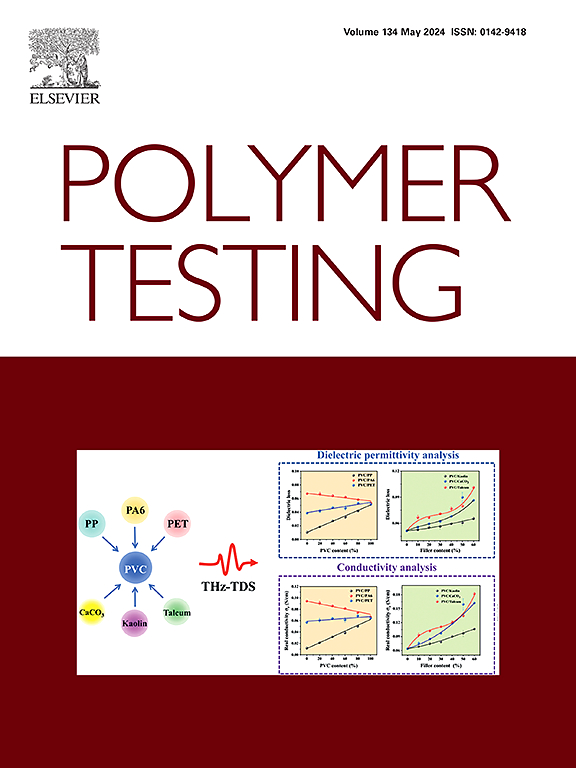Modeling and application of temperature-dependent elastic constants in continuous fiber-reinforced shape memory polymer composites
IF 6
2区 材料科学
Q1 MATERIALS SCIENCE, CHARACTERIZATION & TESTING
引用次数: 0
Abstract
The mechanical properties of continuous fiber-reinforced shape memory polymer composites (SMPCs) exhibit a pronounced temperature dependence. However, exiting models for elastic constants are not specifically developed for SMPCs. In this study, analytical models based on a revised Eshelby's inclusion theory are developed to predict the temperature-dependent longitudinal, transverse, and flexural moduli of SMPCs. Experimental data from the literature, covering SMPCs with various fiber volume fractions (4.32 %, 6.36 % and 12.97 %), are used to validate the proposed models. Validation results show high predictive accuracy for flexural modulus across all fiber content systems, while predictions for longitudinal and transverse moduli exhibit limitations at the high fiber contents (12.97 %). To overcome these constraints, a refined Rule of Mixtures for longitudinal modulus and a revised Chamis model for transverse modulus are introduced. Further numerical investigations on several classic micromechanical models reveal that the revised Chamis formulation effectively captures the temperature-dependent evolution of shear modulus. Furthermore, by incorporating the concept of storage strain, these analytical models are implemented into the commercial finite element software ABAQUS via the UMAT subroutine, enabling finite element simulation of SMPC shape memory cycles. The recovery stress under different constraining strain is also numerically investigated. Overall, the results demonstrate the developed model's capability to predict the temperature-dependent elastic constants and shape memory behavior of SMPCs. This framework bridges critical gaps between micromechanical theory and macroscale SMPC performance, providing a robust tool for multi-physics-coupled smart structure design.
连续纤维增强形状记忆聚合物复合材料中温度相关弹性常数的建模与应用
连续纤维增强形状记忆聚合物复合材料(SMPCs)的力学性能表现出明显的温度依赖性。然而,现有的弹性常数模型并不是专门针对smpc开发的。在这项研究中,基于修正的Eshelby包涵理论建立了分析模型来预测smpc的纵向、横向和弯曲模量随温度的变化。实验数据来自文献,涵盖不同纤维体积分数(4.32%,6.36%和12.97%)的smpc,用于验证所提出的模型。验证结果表明,在所有纤维含量系统中,弯曲模量的预测精度很高,而纵向和横向模量的预测在高纤维含量(12.97%)时表现出局限性。为了克服这些限制,引入了改进的纵向模量混合规则和修正的横向模量Chamis模型。对几个经典细观力学模型的进一步数值研究表明,修正的Chamis公式有效地捕捉了剪切模量随温度的演化。此外,通过引入存储应变的概念,这些分析模型通过UMAT子程序实现到商业有限元软件ABAQUS中,实现了SMPC形状记忆周期的有限元模拟。并对不同约束应变下的恢复应力进行了数值研究。总体而言,结果表明所开发的模型能够预测smpc的温度相关弹性常数和形状记忆行为。该框架在微观力学理论和宏观尺度SMPC性能之间架起了桥梁,为多物理场耦合智能结构设计提供了一个强大的工具。
本文章由计算机程序翻译,如有差异,请以英文原文为准。
求助全文
约1分钟内获得全文
求助全文
来源期刊

Polymer Testing
工程技术-材料科学:表征与测试
CiteScore
10.70
自引率
5.90%
发文量
328
审稿时长
44 days
期刊介绍:
Polymer Testing focuses on the testing, analysis and characterization of polymer materials, including both synthetic and natural or biobased polymers. Novel testing methods and the testing of novel polymeric materials in bulk, solution and dispersion is covered. In addition, we welcome the submission of the testing of polymeric materials for a wide range of applications and industrial products as well as nanoscale characterization.
The scope includes but is not limited to the following main topics:
Novel testing methods and Chemical analysis
• mechanical, thermal, electrical, chemical, imaging, spectroscopy, scattering and rheology
Physical properties and behaviour of novel polymer systems
• nanoscale properties, morphology, transport properties
Degradation and recycling of polymeric materials when combined with novel testing or characterization methods
• degradation, biodegradation, ageing and fire retardancy
Modelling and Simulation work will be only considered when it is linked to new or previously published experimental results.
 求助内容:
求助内容: 应助结果提醒方式:
应助结果提醒方式:


